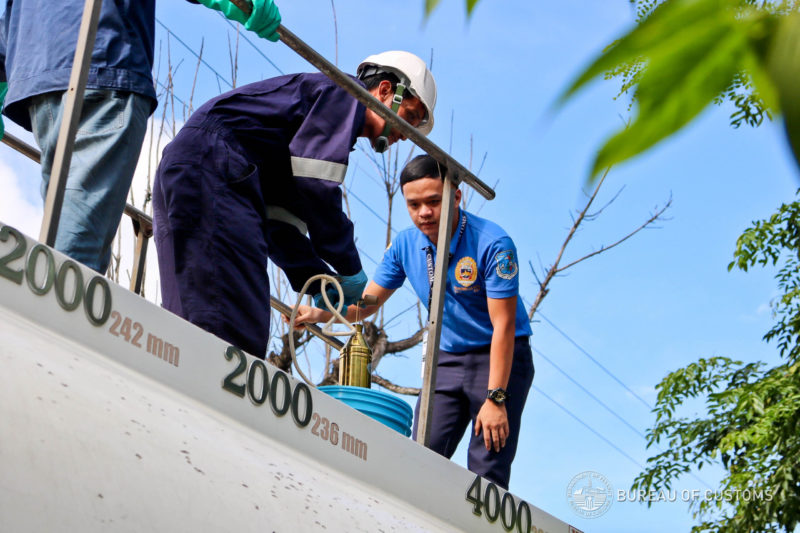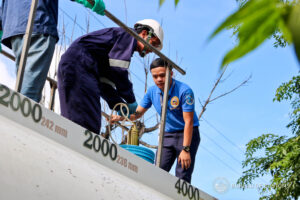

The guidelines on implementation of field testing of fuels under the Philippine government’s fuel marking program are being finalized by the Department of Finance (DOF), Bureau of Customs (BOC), and Bureau of Internal Revenue (BIR).
In preparing to carry out fuel field testing, BOC and BIR have conducted covert sampling of fuels from various retail stations in the National Capital Region, Central Luzon, and CALABARZON (Cavite, Laguna, Batangas, Rizal, Quezon). Last September 16, they conducted a compliance check on tank trucks exiting Tipo Gate in Subic, Zambales.
The fuel marking program, which was initially launched in September last year, has two parts: fuel marking, which started last year, and random field and confirmatory testing, slated to start last February before the pandemic outbreak.
Under Customs Memorandum Order No. 43-2019 that implements the fuel marking program, after carrying out fuel marking, random field tests must be conducted periodically to check for fuel companies’ compliance with the marking requirement.
The fuel marking service provider is mandated to develop and implement a comprehensive field testing program covering the network of retail sites, fuel storage facilities, conveyances and warehouses in the country. For its part, BOC is directed to supervise the field testing areas such as vessels, depots, warehouses, tank trucks, or other similar fuel-transporting vehicles.
Collection of marking fee
Relatedly, DOF, BOC and BIR have issued recently Joint Memorandum Order 1-2020, prescribing the guidelines for the collection and disbursement of fuel marking fee. The fee—amounting to P0.06884 per liter—will be used to defray the costs for the second to fifth year of implementing the program, BOC said.
READ: Oil firms to pay fuel marking fees from Sept 4
For the first year of implementation, a total of 12.051 billion liters of fuel were marked, amounting to a total of P126.55 billion duties and taxes collected by BOC and BIR. The Seaoil Mabini Terminal was the first oil company to have its fuel products marked on September 4 last year.
DOF earlier reported that of the total duties and taxes collected, P107.77 billion were duties and taxes collected by BOC from September 2019 up to September 3, 2020, while BIR collected P18.74 billion in oil excise taxes from December 2019 to August 20, 2020.
READ: Fuel marking program yields P126.5B in first year
Diesel comprised the bulk or 62.05% of the total volume marked, followed by gasoline with 37.43% and kerosene with 0.51%. As to location, 75% of the marking was done in Luzon, 20% in Mindanao, and 5% in the Visayas.
A total of 20 oil firms have participated in the program, with Petron Corp. leading with 2.79 billion liters or 23.12% of the total. This was followed by Pilipinas Shell Petroleum Corp. with 2.44 billion liters or 20.21%, Unioil Petroleum Philippines, Inc. with 1.29 billion liters or 10.77%, Seaoil Philippines, Inc. with 1.02 billion liters or 8.5%, and Chevron Philippines, Inc. with 1.01 billion liters or 8.46%.
The 15 other companies were Phoenix Petroleum Philippines, Inc. (878.8 million liters); Insular Oil Corp. (764.59 million liters); Total Philippines (396.38 million liters); Jetti Petroleum, Inc. (326.48 million liters); PTT Philippines Corp. (201.95 million liters); Filoil Energy Co., Inc. (185.55 million liters); Marubeni Philippines Corp. (183.06 million liters); Micro Dragon Petroleum, Inc. (135.74 million liters); Warbucks Industries Corp. (96.42 million liters); Goldenshare Commerce and Trading, Inc. (85.31 million liters); High Glory Subic International Logistics, Inc. (74.85 million liters); Era1 Petroleum Corp. (68.7 million liters); SL Harbor (51.06 million liters); Jadelink Subic Inc. (21.92 million liters), and SL Gas (18.37 million liters).
Marking of fuel products, whether imported or manufactured in the Philippines, becomes mandatory five years after the Tax Reform for Acceleration and Inclusion (TRAIN) law took effect January 2018. Fuel marking aims to curb oil smuggling and plug revenue losses arising from the illegal importation or misdeclaration of petroleum products.




